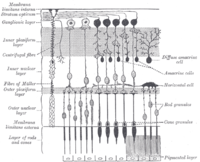
Photo from wikipedia
Recent evidence suggests that melanopsin-expressing intrinsically photosensitive retinal ganglion cells (ipRGCs), a neuronal class regulating nonimage forming (NIF) vision and generally thought to be injury resistant, are dysfunctional in certain… Click to show full abstract
Recent evidence suggests that melanopsin-expressing intrinsically photosensitive retinal ganglion cells (ipRGCs), a neuronal class regulating nonimage forming (NIF) vision and generally thought to be injury resistant, are dysfunctional in certain neurodegenerative diseases. Although disrupted NIF visual functions have been reported in patients and animals with diabetes, it remains controversial whether ipRGCs exhibit remodeling during diabetes and if so, whether such remodeling is variable among ipRGC subtypes. Here, we demonstrate that survival, soma-dendritic profiles, and melanopsin-based functional activity of M1 ipRGCs were unaltered in streptozotocin-induced 3-month diabetic mice. Such resistance remained at 6 months after streptozotocin administration. In contrast, M2/M3 ipRGCs underwent significant remodeling in diabetic mice, manifested by enlarged somata and increased dendritic branching complexity. Consistent with the unaltered melanopsin levels, the sensitivity of melanopsin-based activity was unchanged in surviving M2 cells, but their response gain displayed a compensatory enhancement. Meanwhile, the pupillary light reflex, a NIF visual function controlled by M2 cells, was found to be impaired in diabetic animals. The resistance of M1 cells might be attributed to the adjacency of their dendrites to capillaries, which makes them less disturbed by the impaired retinal blood supply at the early stage of diabetes.
Journal Title: Diabetes
Year Published: 2021
Link to full text (if available)
Share on Social Media: Sign Up to like & get
recommendations!